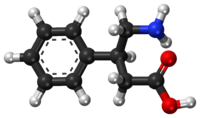 | |
 | |
| Clinical data | |
|---|---|
| Trade names | Anvifen, Fenibut, Noofen, others[1] |
| Other names | Aminophenylbutyric acid; Fenibut; Fenigam; Phenigam; Phenybut; Phenygam; Phenylgamma; Phenigama; PHG; PhGABA; β-Phenyl-γ-aminobutyric acid; β-Phenyl-GABA[2] |
| Routes of administration | Common: Oral[3] Uncommon: Rectal[3] |
| Drug class | GABAB receptor agonist; Gabapentinoid |
| ATC code | |
| Legal status | |
| Legal status | |
| Pharmacokinetic data | |
| Bioavailability | ≥63% (250 mg)[5] |
| Metabolism | Liver (minimal)[6][5] |
| Metabolites | Inactive[6] |
| Onset of action | Oral: 2–4 hours[3] Rectal: 20–30 minutes[3] |
| Elimination half-life | 5.3 hours (250 mg)[5] |
| Duration of action | 15–24 hours (1–3 g)[3] |
| Excretion | Urine: 63% (unchanged)[5] |
| Identifiers | |
| |
| CAS Number |
|
| PubChem CID | |
| ChemSpider | |
| UNII | |
| KEGG | |
| ChEMBL | |
| CompTox Dashboard (EPA) | |
| ECHA InfoCard | 100.012.800 |
| Chemical and physical data | |
| Formula | C10H13NO2 |
| Molar mass | 179.219 g·mol−1 |
| 3D model (JSmol) | |
| Melting point | 253 °C (487 °F) |
| |
| |
| (verify) | |
Phenibut, sold under the brand name Anvifen among others,[1] is a central nervous system (CNS) depressant with anxiolytic effects, and is used to treat anxiety, insomnia, and for a variety of other indications.[5] It is usually taken orally (swallowed by mouth), but may be given intravenously.[6][5]
Side effects of phenibut can include sedation, sleepiness, nausea, irritability, agitation, dizziness, euphoria, and sometimes headache, among others.[6][7] Overdose of phenibut can produce marked central nervous system depression including unconsciousness.[6][7] The medication is structurally related to the neurotransmitter γ-aminobutyric acid (GABA), and hence is a GABA analogue.[5] Phenibut is thought to act as a GABAB receptor agonist, similarly to baclofen and γ-hydroxybutyrate (GHB).[5] However, at low concentrations, phenibut mildly increases the concentration of dopamine in the brain, providing stimulatory effects in addition to the anxiolysis.[8]
Phenibut was developed in the Soviet Union and was introduced for medical use in the 1960s.[5] Today, it is marketed for medical use in Russia, Ukraine, Belarus, Kazakhstan, and Latvia.[5] The medication is not approved for clinical use in the United States and most of Europe, but it is sold on the Internet as a supplement and purported nootropic.[3][9] Phenibut has been used recreationally and can produce euphoria as well as addiction, dependence, and withdrawal.[3] It is a controlled substance in Australia, and it has been suggested that its legal status should be reconsidered in Europe as well.[3] In Germany, phenibut is not approved as a drug and, as a food supplement, is controlled under the German New Psychoactive Substances Act.[10]
In a 2023 assessment, the U.S. Food and Drug Administration (FDA) determined that phenibut does not meet the definition of a dietary ingredient, thereby making phenibut supplement products misbranded and illegal for marketing.[11] FDA warning letters had been issued to supplement manufacturers marketing phenibut products as adulterated.[12]
- ^ a b Drobizhev MY, Fedotova AV, Kikta SV, Antohin EY (2016). "Феномен аминофенилмасляной кислоты" [Phenomenon of aminophenylbutyric acid]. Russian Medical Journal (in Russian). 2017 (24): 1657–1663. ISSN 1382-4368. Archived from the original on 16 September 2017. Retrieved 16 September 2017.
- ^ Elks J (14 November 2014). The Dictionary of Drugs: Chemical Data: Chemical Data, Structures and Bibliographies. Springer. pp. 69–. ISBN 978-1-4757-2085-3.
- ^ a b c d e f g h Cite error: The named reference
pmid26693960was invoked but never defined (see the help page). - ^ Nutrition, Center for Food Safety and Applied (6 March 2023). "Phenibut in Dietary Supplements". FDA. Archived from the original on 23 May 2023. Retrieved 23 May 2023.
- ^ a b c d e f g h i j Lapin I (2001). "Phenibut (beta-phenyl-GABA): a tranquilizer and nootropic drug". CNS Drug Reviews. 7 (4): 471–81. doi:10.1111/j.1527-3458.2001.tb00211.x. PMC 6494145. PMID 11830761.
- ^ a b c d e Ozon Pharm, Fenibut (PDF), archived from the original (PDF) on 16 September 2017, retrieved 15 September 2017
- ^ a b Cite error: The named reference
RLS-Phenibutwas invoked but never defined (see the help page). - ^ Lapin I (7 June 2006). "Phenibut (beta-phenyl-GABA): a tranquilizer and nootropic drug". CNS Drug Reviews. 7 (4): 471–81. doi:10.1111/j.1527-3458.2001.tb00211.x. PMC 6494145. PMID 11830761.
- ^ Cohen PA, Ellison RR, Travis JC, Gaufberg SV, Gerona R (April 2022). "Quantity of phenibut in dietary supplements before and after FDA warnings". Clinical Toxicology. 60 (4): 486–488. doi:10.1080/15563650.2021.1973020. PMID 34550038. S2CID 237594860.
- ^ "Anlage NpSG - Einzelnorm". www.gesetze-im-internet.de. Retrieved 7 June 2024.
- ^ "Phenibut in Dietary Supplements". US Food and Drug Administration. 12 July 2023. Retrieved 14 September 2024.
- ^ "FDA Acts on Dietary Supplements Containing DMHA and Phenibut". US Food and Drug Administration. 29 April 2019. Retrieved 14 September 2024.